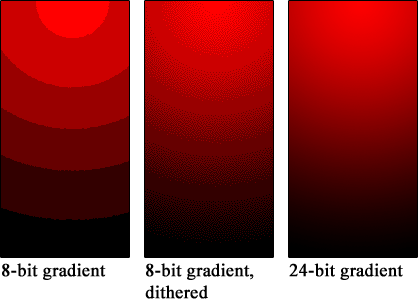Colour banding

(disable browser zoom to see image without rescaling)

Colour banding, or Color banding (American English) is a problem of inaccurate colour presentation in computer graphics. In 24-bit colour modes, 8 bits per channel is usually considered sufficient to render images in Rec. 709 or sRGB. However, in some cases there is a risk of producing abrupt changes between shades of the same colour. For instance, displaying natural gradients (like sunsets, dawns or clear blue skies) can show minor banding.
Colour banding is more noticeable with fewer bits per pixel (BPP) at 16–256 colours (4–8 BPP), where not every shade can be shown without dithering.
Possible solutions include the introduction of dithering and increasing the number of bits per colour channel. Blurring does not fix this, unless one actually increases the number of levels available so that the blur can render color in intermediate levels.
